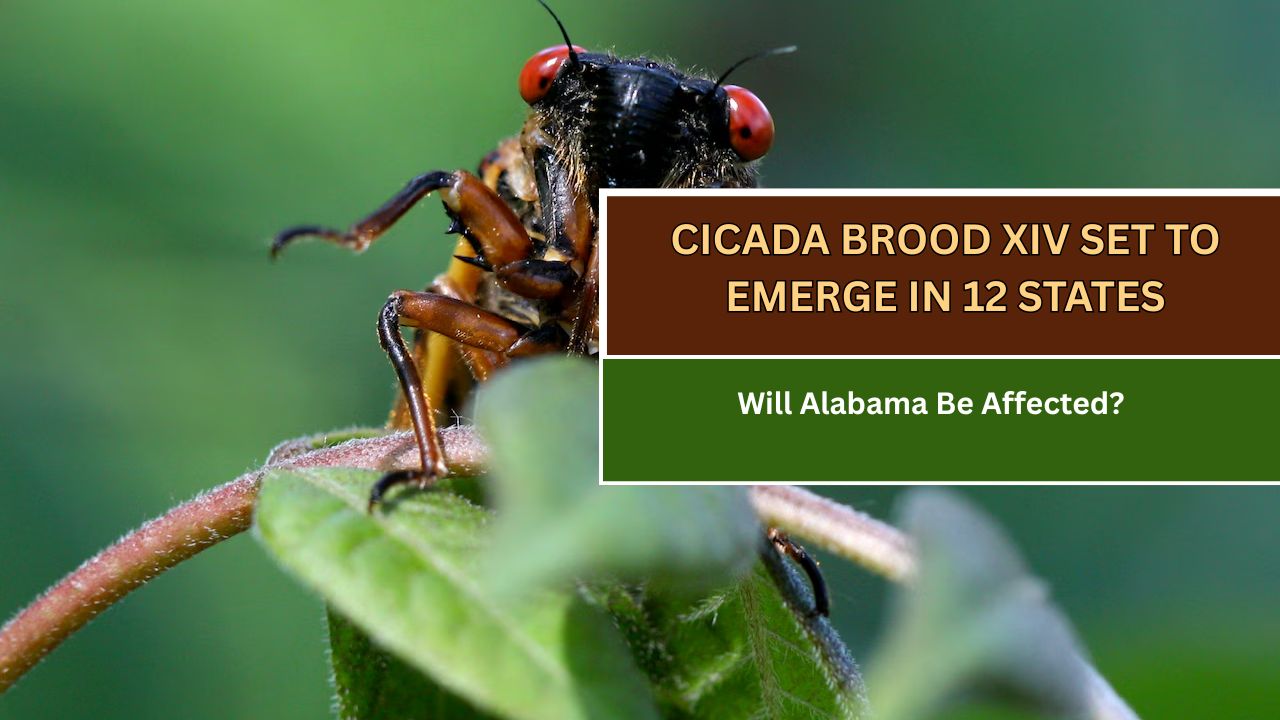Billions of cicadas are set to swarm parts of the United States this spring as Brood XIV, one of the largest periodical cicada groups, emerges for the first time in 17 years. But for curious residents of Alabama, the question is: Will these noisy visitors show up here?
According to researchers at the University of Connecticut, Brood XIV, also known as the “Greater Eastern Brood,” will emerge when the soil temperature reaches 64 degrees Fahrenheit. These cicadas spend 17 years underground, feeding on plant roots before rising to the surface in massive numbers to mate, lay eggs, and die—starting the cycle all over again.
“These cicadas have a very specific life cycle and only appear when conditions are just right,” noted UConn cicada researchers.
Where Will Brood XIV Cicadas Appear?
Brood XIV is expected to emerge across at least 12 U.S. states, with its population centered around Kentucky and southern Ohio. Additional states likely to experience the emergence include:
- Georgia
- Maryland
- Massachusetts
- New Jersey
- New York
- North Carolina
- Pennsylvania
- Tennessee
- Virginia
- West Virginia
While Brood XIV cicadas are native to the eastern United States, this specific brood’s reach is unique in a few ways. Notably, Cape Cod in Massachusetts and Long Island, New York, will host some of the insects—an uncommon event due to the sandy soil, which typically doesn’t support cicada development.
What About Alabama?
For residents of Alabama, there’s little chance of witnessing this year’s Brood XIV event.
The University of Connecticut cicada map shows that only one sighting of Brood XIV was reported in the state during its last appearance in 2008—and that occurred in Jackson County.
“There is no strong indication that Brood XIV will reappear in Alabama this year,” experts confirmed.
Alabamians eager to see the cicadas in action would likely need to travel north to Tennessee or east to Georgia, where the emergence is expected.
Alabama’s Own Cicada Broods
Although Brood XIV won’t be making a widespread appearance in Alabama, the state has its own history of cicada activity.
Just last year, two separate broods emerged across the Midwest and southeastern U.S., including Brood XIX—which was widely reported in Alabama. These sightings occurred especially in Black Belt counties and northern parts of the state, according to USA Today’s cicada tracking map.
Brood XIX, also known as the Great Southern Brood, operates on a 13-year cycle, in contrast to Brood XIV’s 17-year timeline. It’s expected to return again in 2036.
What Are Broods, Exactly?
In the U.S., scientists recognize 15 distinct “broods” of periodical cicadas, each assigned a Roman numeral. These groups are named based on the year they emerge and their geographic location. Periodical cicadas are distinct from annual cicadas, which appear every year in smaller numbers.
Periodical cicadas spend 13 or 17 years underground, depending on their brood. Once the ground temperature warms in spring, they surface, molt into adults, mate, lay eggs, and die—all within a few weeks.
When the eggs hatch, the tiny nymphs fall to the ground and burrow into the soil, starting the long underground cycle again.
Why Do Cicadas Emerge in Such Large Numbers?
Scientists believe that the mass synchronized emergence of cicadas helps overwhelm predators, like birds and squirrels, ensuring that enough adults survive to reproduce. This phenomenon is known as predator satiation.
“They don’t bite, they don’t sting—they’re just loud and numerous,” said entomologists at USDA’s Forest Service.
“And they’re a fascinating part of nature’s clockwork.”
Resources for Tracking Cicada Activity
If you’re interested in tracking the emergence or confirming if cicadas will reach your area, these tools and websites can help:
- 🔗 University of Connecticut Periodical Cicada Mapping Project
- 🔗 USA Today’s Cicada Tracker
- 🔗 National Weather Service Soil Temperature Tool
Final Thoughts
While Alabama likely won’t experience the buzzing phenomenon of Brood XIV this spring, nearby states like Tennessee and Georgia will provide a front-row seat. And for those in Alabama who remember the 2011 and 2024 appearances of Brood XIX, another incredible display is already on the calendar—for 2036.
Until then, enjoy the peace and quiet while it lasts.
This article has been carefully fact-checked by our editorial team to ensure accuracy and eliminate any misleading information. We are committed to maintaining the highest standards of integrity in our content.

Outside of work, he enjoys playing chess, following cricket, and writing short stories. His commitment to integrity and in-depth analysis strengthens OTE News’ mission of providing trustworthy journalism.



